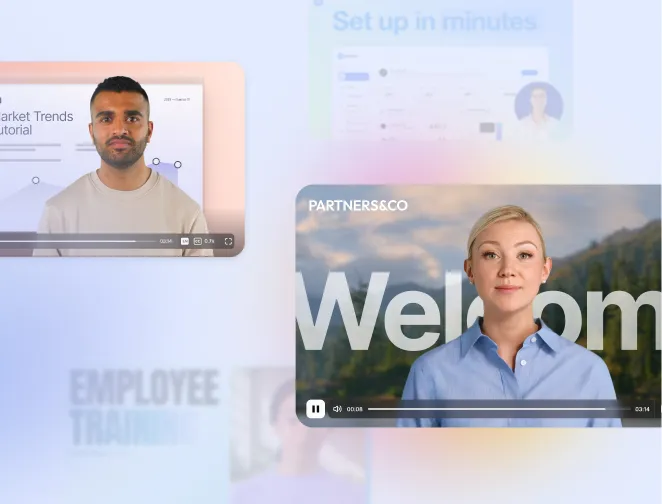
Create AI videos with 230+ avatars in 140+ languages.
I've worked with dozens of sales teams struggling with the same problem: their reps spend hours in repetitive training sessions, yet still can't confidently handle the top five objections.
Meanwhile, L&D teams are drowning in content requests they can't fulfill fast enough.
The solution? Strategic sales enablement videos that transform ordinary reps into top performers by delivering exactly what they need, when they need it.
Video is the backbone of modern sales enablement strategy.
In my experience working with sales organizations, those who leverage video consistently outperform teams stuck with PDFs and PowerPoints.
I'll show you how to use AI-powered video to slash training costs, accelerate onboarding, and boost sales performance across your entire organization.
Why video is crucial for sales enablement
Video drives better retention and engagement than traditional methods. The benefits are clear and measurable:
- Higher engagement and information retention compared to text
- Measurable results through analytics
- Consistency in messaging across your entire sales organization
- On-demand accessibility across all devices
Video does more than make emails look nicer. It can boost click-through rates by hundreds of percent and increase close rates by 40% or more. That kind of improvement has a direct effect on pipeline and revenue.
What sales teams actually need
Before diving into implementation, let's be clear about what modern sales enablement actually requires. The old playbook of 60-page PDFs and 2-hour training sessions doesn't cut it anymore.
Today's sales teams need interactive, digestible content that can be consumed between calls.
They need materials that update easily when products or processes change, without requiring complete re-recording. Most importantly, they need consistent messaging across global teams, with measurable impact on performance metrics. If you can't track whether your training actually improves win rates, you're flying blind.
Step 1: Audit your current sales training challenges
Start by identifying your key pain points in sales enablement. This is key to understanding your real costs and inefficiencies.
- Document how much time managers spend on repetitive training versus strategic coaching
- Calculate your current costs for video production, voiceovers, and localization (traditional video production typically costs $1,000-$3,000 per minute; AI video reduces this to under $100)
- Factor in the time spent on traditional video creation (typically 30-60 hours per video)
- Evaluate knowledge retention, manager time allocation, production costs, and localization challenges
Step 2: Start with high-impact content creation
Convert your existing sales training materials to video with Synthesia's AI Video Assistant
- Convert existing materials first: Transform sales playbooks, battle cards, and presentations into engaging videos (1-2 days per asset)
- Create scenario-based training: Develop realistic role-play situations for objection handling (2-3 hours per scenario)
- Develop modular onboarding: Break content into digestible 2-3 minute videos for self-paced learning
I recommend starting with your top 5 objections and creating standardized responses. A common mistake I often see is creating videos that are too long. I like to try and keep them under 3 minutes for maximum retention.
How to prioritize your first 5 videos
The most successful implementations I've seen follow this prioritization framework:
- High-frequency objections (what reps hear weekly)
- Demo moments that differentiate you from competitors
- Process changes that caused recent confusion
- Content that currently requires live delivery from managers
For instance, if your reps are losing deals to a specific competitor, create a 90-second competitive positioning video before building general product training.
This targeted approach delivers immediate impact while you build out your broader library.
Step 3: Solve real problems with smart features
Instead of listing features, let me show you how to solve the actual problems your team faces:
Problem: Creating separate videos for each region is cost-prohibitive.
Solution: 1-click translations enable you to scale content globally without expensive voiceover costs. One team I worked with translated their onboarding series into 8 languages in less than a day.
Problem: Static videos don't engage modern learners.
Solution: Multiple AI avatars create conversational scenarios that feel like real customer interactions, not lectures.
Problem: Writers' block slows down content creation.
Solution: AI Video Assistant helps you overcome creative blocks and generate scripts faster, turning bullet points into polished narratives.
Problem: Sales teams waste hours re-recording videos when product names or pricing change
Solution: Smart Updates lets you edit scripts and regenerate videos in minutes, not hours. I've seen teams update an entire 20-video series with new pricing in a single afternoon.
Step 4: Build scalable training programs
Now you're ready to ramp things up. I recommendt that you:
- Create evergreen presenter content using consistent avatars
- Develop role-specific tracks by customizing content for different sales roles
- Establish template libraries for common training scenarios
Building your template library
One pattern I've noticed repeatedly is that teams that build strong template libraries scale faster. I suggest that you focus on these reusable formats:
- Objection response template: Context card → model answer → practice prompt → CTA
- Demo intro template: Problem statement → solution preview → key differentiator → transition to demo
- Competitive landmine template: Competitor claim → reframe → proof point → redirect to strength
- Feature update template: What changed → why it matters → how to position → practice exercise
I recommend creating standardized intro/outro segments that appear in every video. This builds familiarity and reinforces your brand while saving production time.
Step 5: Integrate with your existing sales tech stack
Good tracking goes beyond views. Track which videos correlate with faster ramp time or higher win rates.
For example, if reps who watch your objection handling series close 15% more deals, you know where to invest.
The goal is connecting video consumption to actual sales performance, rather just completion certificates.
- Connect to your learning management system (Showpad, Highspot, or Seismic)
- Export SCORM-compliant content for seamless LMS compatibility
- Track engagement metrics to monitor which videos drive the best outcomes
Step 6: Continuous improvement process
Organizations using our AI video technology report dramatically faster creation, significant cost reductions (up to 70% on localization alone), and the ability to create hundreds of micro-videos in just months.
The ease of AI video creation allows you to adopt a process of continuous improvement. AI video allows you to:
- Regularly update content based on market changes and feedback
- A/B test different approaches to find what resonates best
- Expand successful pilots to other departments easily
- Collect feedback through automated surveys, performance correlation, focus groups, and usage analytics
Using interactive product demos and video analytics
Interactive elements transform passive viewing into active learning. Here's how the most successful teams use these features:
- Branching scenarios for objection handling: "If prospect says price is too high, click here; if they mention security concerns, click here." This lets reps practice decision-making in a safe environment.
- Quiz integration for knowledge checks: Add 2-3 questions after each module. "What metric does this objection reframe to?" These quick checks reinforce learning and identify knowledge gaps.
- Practice assignment prompts: "After watching, record a 30-second response using the acknowledge → reframe → question pattern." This bridges the gap between knowing and doing.
Monitor key metrics including completion rates, drop-off points, quiz performance, and time to competency. I recommend shortening videos with high drop-off rates or breaking content into smaller segments based on this data.
Personalizing and localizing video content at scale
Our AI avatars eliminate production bottlenecks, with over 240 diverse options in Synthesia. Our one-click translations transform content into multiple languages without hiring voice actors, reducing video localization costs by up to 70%.
We've designed our platform to shrink the traditional video timeline from weeks to hours, enabling quick responses to market changes. This speed matters when you're racing to enable your team on competitive intelligence or new product features.
About the author
Strategic Advisor
Kevin Alster
Kevin Alster is a Strategic Advisor at Synthesia, where he helps global enterprises apply generative AI to improve learning, communication, and organizational performance. His work focuses on translating emerging technology into practical business solutions that scale.He brings over a decade of experience in education, learning design, and media innovation, having developed enterprise programs for organizations such as General Assembly, The School of The New York Times, and Sotheby’s Institute of Art. Kevin combines creative thinking with structured problem-solving to help companies build the capabilities they need to adapt and grow.

Frequently asked questions
What are the first sales enablement videos I should create with Synthesia to see quick impact?
Start with your top 5 objections and create standardized response videos that give your reps exact phrases to use. Focus on high-frequency objections your team hears weekly, competitive positioning against your main rival, and any recent process changes causing confusion. Keep each video under 3 minutes and include model language, not just concepts.
The most successful teams prioritize content that currently requires live delivery from managers, such as demo moments that differentiate you from competitors. For example, if your reps consistently lose deals to a specific competitor, create a 90-second competitive positioning video before building general product training. This targeted approach delivers immediate impact while you build out your broader video library and helps reps handle real-world selling situations with confidence.
How does Synthesia reduce the cost and time of creating and updating sales training content?
Traditional video production typically costs $1,000-$3,000 per minute and takes 30-60 hours per video, but AI video creation reduces this to under $100 per minute with production time measured in hours, not weeks. You can update scripts and regenerate videos in minutes when products or pricing change, eliminating expensive re-recording sessions. One company saved $100,000 on video production while increasing view retention by 200%.
The platform's Smart Updates feature lets you edit text and instantly regenerate videos without starting from scratch. Teams report updating entire 20-video series with new pricing in a single afternoon, and creating sales training videos 95% faster than traditional methods. This speed and cost efficiency means you can create hundreds of micro-learning videos, maintain fresh content, and respond quickly to market changes while keeping your sales enablement budget under control.
How can I personalize and localize sales enablement videos for global teams using Synthesia?
With over 240 diverse AI avatars and one-click translation into 140+ languages, you can create culturally relevant content for every region without hiring local voice actors or production teams. The platform reduces localization costs by up to 70% while maintaining consistent messaging across all markets. Teams translate entire onboarding series into 8 languages in less than a day.
Beyond language translation, you can customize content for specific regions by selecting appropriate avatars, adjusting examples to local markets, and even personalizing videos to address viewers by name. This level of personalization helps global sales teams feel connected to training materials while ensuring everyone receives the same quality of enablement resources, regardless of their location or language preference.
Which metrics should I track to measure the business impact of my sales enablement videos?
Track engagement metrics like completion rates, drop-off timestamps, and which segments get rewatched to understand how reps consume your content. Monitor behavioral changes including time-to-first-call for new hires, number of practice submissions, and meeting-to-opportunity conversion rates. Most importantly, measure outcome metrics such as changes in objection win rates and compare deals where reps watched primer videos versus those that didn't.
Good tracking goes beyond views to connect video consumption with actual sales performance. For example, if reps who watch your objection handling series close 15% more deals, you know where to invest next. Use this data to shorten videos with high drop-off rates, identify knowledge gaps through quiz performance, and continuously refine your training program for maximum impact on revenue.
How do I integrate Synthesia videos into our existing LMS or sales enablement platforms?
Synthesia exports SCORM-compliant content that seamlessly integrates with major learning management systems like Showpad, Highspot, and Seismic. You can embed videos directly into your existing sales enablement platform, maintaining all your tracking and reporting capabilities while adding engaging video content. The platform connects with your current tech stack without requiring complex technical implementation.
Set up automated workflows to push new videos to your LMS, track engagement through your existing analytics dashboards, and maintain version control across all platforms. This integration ensures your sales reps access video content through familiar channels while you monitor performance metrics in one centralized location, making it easy to measure ROI and optimize your sales enablement strategy over time.














